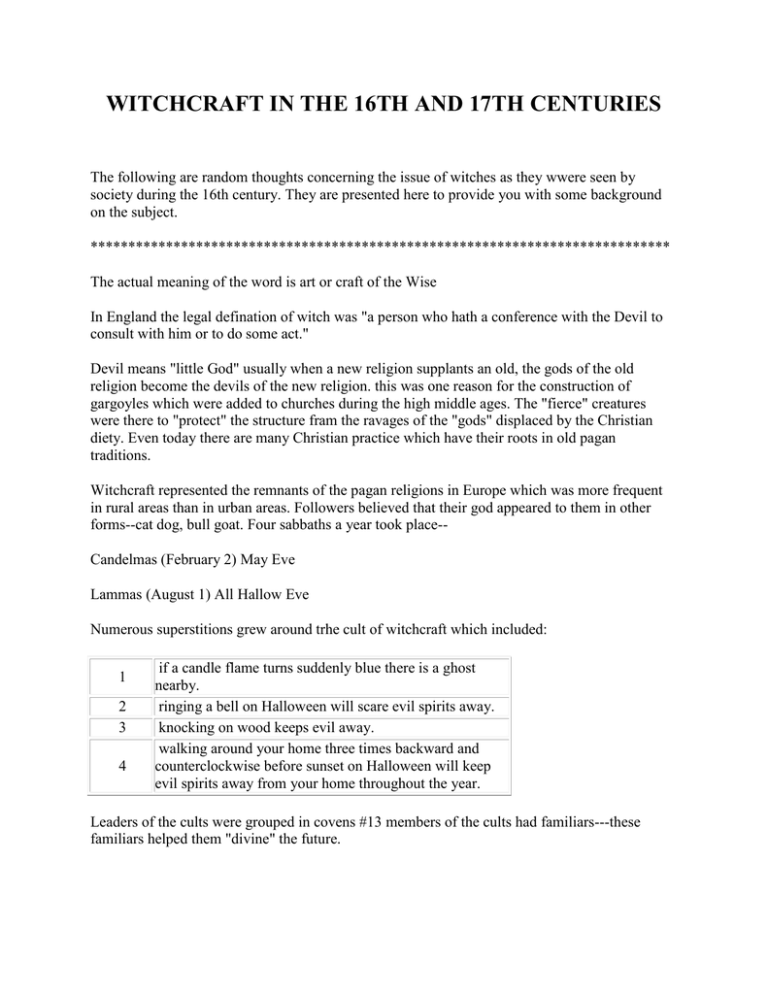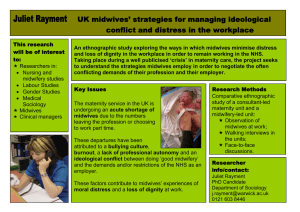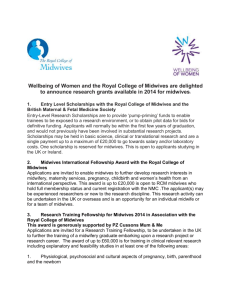WITCHCRAFT IN THE 16TH AND 17TH CENTURIES
advertisement

WITCHCRAFT IN THE 16TH AND 17TH CENTURIES The following are random thoughts concerning the issue of witches as they wwere seen by society during the 16th century. They are presented here to provide you with some background on the subject. ***************************************************************************** The actual meaning of the word is art or craft of the Wise In England the legal defination of witch was "a person who hath a conference with the Devil to consult with him or to do some act." Devil means "little God" usually when a new religion supplants an old, the gods of the old religion become the devils of the new religion. this was one reason for the construction of gargoyles which were added to churches during the high middle ages. The "fierce" creatures were there to "protect" the structure fram the ravages of the "gods" displaced by the Christian diety. Even today there are many Christian practice which have their roots in old pagan traditions. Witchcraft represented the remnants of the pagan religions in Europe which was more frequent in rural areas than in urban areas. Followers believed that their god appeared to them in other forms--cat dog, bull goat. Four sabbaths a year took place-Candelmas (February 2) May Eve Lammas (August 1) All Hallow Eve Numerous superstitions grew around trhe cult of witchcraft which included: 1 2 3 4 if a candle flame turns suddenly blue there is a ghost nearby. ringing a bell on Halloween will scare evil spirits away. knocking on wood keeps evil away. walking around your home three times backward and counterclockwise before sunset on Halloween will keep evil spirits away from your home throughout the year. Leaders of the cults were grouped in covens #13 members of the cults had familiars---these familiars helped them "divine" the future. The Weakie Vessel---Antonia FraserExtended family in England during 1600's was an exception rather than a rule. The medieval welfare system of manor and church was breaking down thus the need to make changes in the social structure became necessay. Elizabethan Poor Laws--made the welfare of the poor the task of the Parish by compulsory taxes which were placed upon its members. There were more poor widows than widowers. People who surrived childhood diseases lived to very old ages-- Demographically if we could return to the 1600's we would find 10% old people, many young people and comparatively few middle aged people. Renaissance individualism had made beauty an important factor. Beauty in a woman corresponded with fertility--post menopausal women were, therefore, not beautiful. Beauty was also increasingly equated with virtue while ugliness was a sign of evil. Women were considered sexually voracious in a time period when Puritanism condemned sexuality when not directed toward procreation. Younger widows often became the village whores or paid for farm work in kind--what were old women to do, consort with Satan? With medical knowledge being limited, tumors, warts, moles were thought of as the Devil's mark. Older widows might actually think they were witches and use their powers for economic gain. They had no protectors and if they inspired guilt or errored on a cure they could be targeted for revenge for their mishaps. They might also have pets which could be interpreted as familiars. Important questions of the time included: Why does a woman show affection to her pet? The vast majority of witches actually tried were both female and old with widows at special risk. Poverty was also a factor. By 1700 most respectable people no longer believed in witches. MIDWIVES: In the 1600's every woman with the opportunity to conceive was likely to give birth at least once in her lifetime. Pregnancy was the norm and women's energies were directed to childbearing. The midwife was a respectable professional and generally earned a good living depending on the social class of her clientele. She had a vested interest in the delivery of healthy babies since she received an additional fee from the godparents at the time of baptism. Paris had a school for midwives, England offered no official training since girls were not trained in Latin, they thus lacked the access to medical knowledge. Generally, it was believed that women, by nature, made better nurses and midwives. Midwives sometimes were too enthusiastic and pulled the child out often ripping off limbs in the process and causing damage to the mother or cut off limbs to make birth faster. Midwives also performed illegal abortions. The forceps were invented in the 17th century by Peter Chamberlain, but he refused to share his knowledge--the secret was kept within the family for financial gain. The instrument was reinvented independently in the 18th century. Midwives were licensed by the church because they often had to baptise dying infants. The midwife's oath included: 1 2 3 4 5 6 help the poor as well as the rich. not to allow a woman to name a man falsely as the father use no sorcery baptise the newborn, only if necessary register the birth with the local authorities and the church not use any cutting or dismembering Note that the oath does not indicate that any actual "medical' training was required. (A thought for students of APEH: If you are to excell at the study of history you must learn to read between the lines. If the oath states that one is not to do something it must mean that it is being done, at least sometimes). By the end of the century, midwives had lost their battles with the doctors. By the 18th century male midwives were common. Louis XIV had one of his children delivered by a male. Lister would not invent disinfectant until 1867. It should be noted that the hands of a doctor and those of a midwife introduced germs into the bodies of the pregnant woman as well as to the child. As doctors became more involved in the birthing process the mortality rate actually climbed. This was because of the type of germs introduced (remember, no one washed their hands). The germs of a midwife were those of the earth, the farm and the like. From their livelyhood many women actually built up an immunity to these (sort of on the job vacination). Men who often dealt in different occupations (even doctors, most of whom had other full time jobs) introduced "new" germs to the woman who thus had no natural immunities. Actually the introduction of the first "lying-in" hospitals led to the first epidemics of child-brith fever (this occured in the 1600's). http://thecaveonline.com/APEH/witchcraftmidwifery.html


![Letter to MPs re: maternal mental health report Dear [Name of MP] I](http://s3.studylib.net/store/data/006839335_1-7d7b3127aade7ad6d126565942ce75c1-300x300.png)



